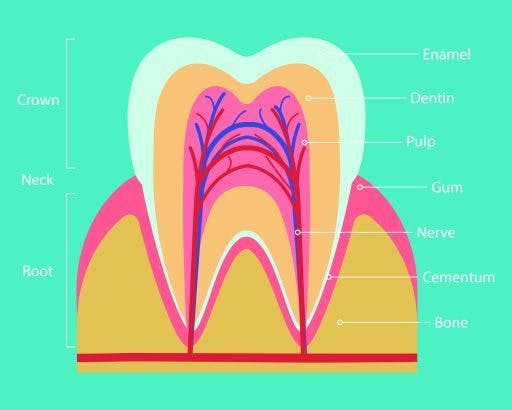When you have a throbbing pain in your mouth, you might assume it is due to a cavity or grinding. But that’s not always the case! You could have a tooth abscess.
It might be tempting to shrug it off. But keep in mind a red, swollen bump (like a pimple) on your gums likely means you have a bacterial infection that needs urgent attention. What other signs should you look out for? Keep reading to learn about tooth abscess symptoms and treatments.
What is a tooth abscess?
According to a Dental Research Journal review, a dental or oral abscess is a “localised collection of pus in the alveolar bone at the root apex of the tooth.” Think of it as a natural defense mechanism to keep an infection from spreading into other areas.
Types of dental abscess
There are three types of tooth abscess based on where it forms in the mouth:
- Gingival abscess – develops around or on the surface of the gums; usually resembles a small pimple
- Periodontal abscess – forms deeper in the gum tissue or pocket; can easily spread to the surrounding bone
- Periapical abscess – occurs in the root of the tooth; leads to extreme pain
Causes of oral abscess
A StatPearls article identifies the main causes – “dental abscesses or periapical infections typically arise secondary to dental caries (tooth rot related to poor dental hygiene), trauma, or failed dental root canal treatment.” Once the tooth’s protective enamel breaks down, bacteria can enter the pulp cavity, cause a local infection, and compress the inner dentin walls. Even a simple tooth chip or crack can lead to this painful condition.
Here are other factors that increase the risk of forming an abscess:
- A partially erupted tooth (wisdom tooth)
- Genetics (i.e., amelogenesis imperfecta, which predisposes individuals to weak enamel)
- Tooth grinding
- Sjögren’s syndrome (an autoimmune disease that leads to a dry mouth)
- Immunosuppressive conditions like HIV/AIDS
- Chemotherapy
- A high-sugar diet
- Smoking
- Steroids
5 tooth abscess stages

Learn the five tooth abscess stages to assess your situation and plan for its management.
1. Enamel decay
Once plaque accumulates on the surface of your tooth and gums, acid forms and erodes the tooth enamel. Consequently, this tooth decay leads to a cavity.
2. Dentin decay
Without treatment, the enamel decay can progress to the sub-layer of your tooth. Bacteria will continue to eat through the dentin, then cause tooth sensitivity.
3. Tooth pulp infection
The next layer is the inner pulp. Here, bacteria can reach the tooth’s nerves and cause them to die. At this stage, your immune system will fight the infection by forming pus, which leads to an oral abscess.
4. Abscess formation
After infecting the pulp, bacteria can spread further into the gums or jawbone. Here, you’ll notice intense swelling, gum redness, and throbbing pain. Most people get immediate treatment at this point.
5. Tooth loss and other complications
Eventually, an untreated abscess can further erode the bone and cause tooth loss. For patients with a weak immune system, the infection can spread into the bloodstream. A treatment plan of tooth abscess antibiotics alone may no longer work at this stage.
The Dental Research Journal article mentioned above warns – “if not treated at an early stage, it may rapidly evolve and spread to adjacent anatomic structures, leading to serious complications such as septicemia, cavernous sinus thrombosis, brain abscess, shock, and occasionally to death.”
Tooth abscess symptoms

Besides the obvious tooth abscess swelling and pain, watch out for these signs that warrant a visit to your dentist ASAP.
- A foul taste in your mouth
- Tender, swollen lymph nodes in the neck or jaw
- Bad breath even after brushing or rinsing
- Discomfort with hot or cold temperatures and sweet substances
- A loose tooth
- Inflamed and shiny gums
- Pain when biting, chewing, or swallowing
- Throbbing pain in your ears, neck, or jaw
- Discomfort when breathing
- Fever
Once the abscess ruptures, you’ll notice a sudden rush of foul-tasting, salty fluid in your mouth. While this occurrence offers pain relief, it also requires immediate medical attention.
Tooth abscess treatment and management
You might be wondering, “Can tooth abscess go away on its own?” Unfortunately, the answer is no. It won’t heal without treatment. But with early management, you can keep the dental abscess from wreaking havoc and destroying your pearly whites. Here are some treatment options:
- Abscess draining: This procedure involves making a small incision in the abscess to drain the pus. The dentist will then clean the infected area with a saline solution, then prescribe antibiotics.
- Root canal treatment: For periapical abscesses, root canal treatment is necessary. Here, the dentist removes the infected pulp in the tooth, then proceeds to draining.
- Tooth extraction: In the worst cases, tooth extraction is the only solution to stop an infection from spreading.
How to prevent dental abscesses
Excellent oral hygiene (i.e., regular brushing, flossing, and dental scaling) will reduce bacterial growth and prevent abscess formation. Make sure to schedule dental visits regularly and have loose or chipped teeth checked immediately. Also, take a more proactive stance in preventing plaque buildup.
Because dental overlaps and overcrowding increase your risk of dental cavities, consult an orthodontist about treatment with ClearCorrect. This invisible aligner can fix your crooked teeth, effectively keeping food particles (and bacteria!) from getting stuck in hard-to-reach areas. Plus, its proprietary tri-layer ClearQuartz material allows your treatment to be as discreet and comfortable as possible.
Eager to find out if you’re a candidate for ClearCorrect? Take this online smile assessment.
Complications from tooth abscesses
An untreated tooth abscess can lead to a range of complications. The infection may spread to your jaw and other parts of your head and neck, resulting in swelling and discomfort. In some cases, the infection can reach your sinus cavity and other nearby tissues. More serious complications can arise, such as sepsis and infections of the heart and brain, which can be life-threatening.
Clearly, having a tooth abscess is no simple matter. It’s a painful condition you want to nip in the bud by early detection and professional intervention. That’s why seeing your dentist as soon as you have a toothache is so important. Early detection is key!
References:
Dental abscess death and morbidity. (n.d.). Australian Journal of General Practice.
Javali, M. A., Betsy, J., Thobaiti, R. S. S. A., Alshahrani, R. A., & Al-Qahtani, H. (2020). Relationship between malocclusion and periodontal disease in patients seeking orthodontic treatment in southwestern Saudi Arabia. Saudi Journal of Medicine and Medical Sciences, 8(2), 133.
Shweta. (2013, October 1). Dental abscess: A microbiological review. PubMed Central (PMC).
Sanders, J. L. (2023, February 20). Dental Abscess. StatPearls – NCBI Bookshelf.



